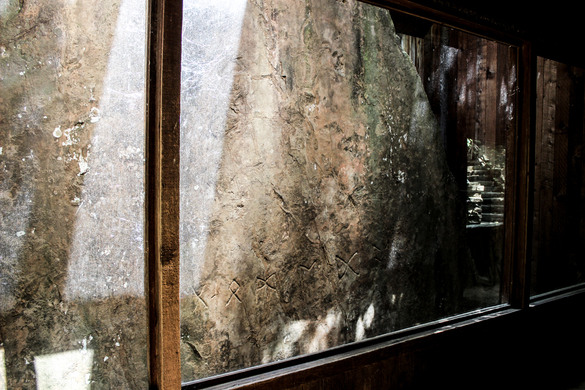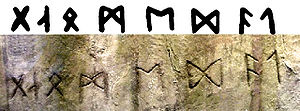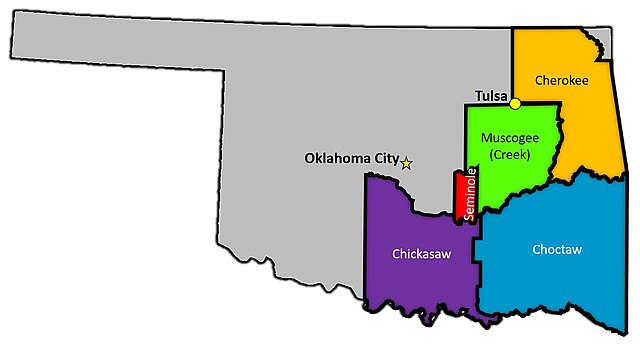Oklahoma, where the wind comes sweepin' down the plain,
And the wavin' wheat can sure smell sweet
When the wind comes right behind the rain.
Oklahoma Statutes, Title 25, ch. 3, §94.3
taken from the 1943 Musical Play Oklahoma!
by Richard Rodgers and Oscar Hammerstein II
Background

A number of years ago, our attention was brought to a curious one-ton Runetone located in a ravine on the top of Heavener Mountain, just east of Heavener, Oklahoma. The person asking about the writing on the Heavener Runestone thought the writing was possibly Paleo-Hebrew, the dialect that Moses used when he wrote his final edition of the Torah (the first five books of the Old Testament, some scholars now think Joseph prepared meticulous notes about the events of the Book of Genesis and left them in his tomb, which is why Moses went out of his way to obtain them, along with Joseph's body. cf. Exodus 13:19). When we examined the picture of the writing on the Runestone, we could see clearly that it was NOT Paleo-Hebrew! Later on, we would find out what language was written on this stone.

But the fact that the writing was not Paleo-Hebrew did not cause us to lose interest in this curious stone. Our website on the subject demonstrates this. The first thing to make us question what we were seeing was how could someone write inscriptions on a Savanah Sandstone rock with a Mohs Scale of 7 (a diamond at 10 is the hardest mineral in nature)! Even more puzzling was that the Heavener Runestone is a heavy rock that is not easy to move, but most experts who have examined the Heavener Runestone contend that the rock was moved from another location. If it was moved from another location, how was it moved from another location? Moving a one-tone rock even in modern times is a massive undertaking that would require expensive equipment (and a lot of money) that they did not have even fifty years ago! How did they do it when they did?
In our era, the Runestone was first spotted by a hunting party from the Choctaw Nation in the early 1830s. The hunting party then sent for their "Medicine Men and Women" to examine the Runestone. They were so horrified that to this day, very few full-blooded Choctaw will live in Heavener. They have never shared their reasons why, so we must search for that answer on our own. It should be further noted that the first white man to observe the rock in "modern" times saw it in 1876 and called it "Indian Rock," wrongly assuming that some member of the Choctaw tribe had made the inscription on the rock (which was technologically impossible for them to do).
An area schoolteacher named Carl F. Kemmerer knew better and used letterhead from the local Masonic Lodge #154 to contact the Smithsonian Institute on March 24, 1923 to ask them about it. They dismissed the Runestone as an "elaborate hoax" and have never followed up on it. Their belief at the time (promoted by Czech-born anthropologist Aleš Hrdlička who was the curator and a major influence on policymaking at the Institution) was that no "white man" had ever stepped foot in North America prior to Christopher Columbus.
Despite the discouraging response from the Smithsonian Institution, Mr. Kemmerer and later Mrs. Gloria Farley (also a schoolteacher) worked to preserve the Heavener Runestone and to get the State of Oklahoma to cristen it a state park. The area remained a state park until state budget cuts caused the State to hand over possession to the City of Heavener, Oklahoma.
Understanding the State of Oklahoma
To understand the Heavener Runestone better, we need to understand the political climate of the area both before the time when the Heavener Runestone was "discovered" and what happened after it was discovered. Most people do not understand that the State of Oklahoma has one of the most complicated political histories of any state in the union. We cannot cover the entire history, but we will look at some of the more salient events.
The State of Oklahoma was oficially admitted to the Union by Congress on November 16, 1907, but its history is considerably older. Some of it, we are just beginning to unravel as we unearth the past. For example, in the 1930s, when treasure hunters bought the rights to tunnel into Craig Mound located several miles south of Spiro, Oklahoma (near Heavener, Oklahoma). What they found continues to shock archaeologists even today. Some estimates suggest that Spiro Mounds once was home to 250,000 people. Yet, by the end of the fifteenth century, most of the residents had left. Even professional archaeologists and pathologists are puzzled? Plenty of theories have been put forth but none of them are totally supported by the existing physical evidence.
According to the "standard" history books, the first white men to visit Oklahoma were the Spanish explorer Hernando de Soto and his exploring party. It has also been suggested suggested that Francisco Vázquez de Coronado and his exploration party might have visited the Oklahoma "panhandle" about the same time or sooner. Coronado's party (and maybe de Soto's party) was looking for the Cities of Cibola, better known in American history as the Seven Cities of Gold. Instead of finding gold, de Soto found a flourishing culture of Tula peoples, part of the Caddo Indian Confederation. Archaeologists now classify the residents as Caddoan Mississippian.
However, by the end of the 18th century, much of this civilization had also disappeared and with it, the opportunity for explorers to "get rich quick." By the 19 th century, interest in the area waned. French "Emperor" Napoleon I, needing money to fight his European Wars, sold Oklahoma (via the Louisiana Purchase) to the United States.

Congress saw a different use for Oklahoma when they passed (and President Andrew Jackson signed, despite the fact that the Act was clearly unconstitutional) the Indian Removal Act of 1830. They saw it as a "dumping ground" for the "Five Civilized" Native American Tribes that inhabited the Southeastern United States. By the mid-1830s, the Choctaw, Chickasaw, Creek, Seminole, and Cherokee had been either forced to sign treaties to give up their land or they were forced out of their native lands and resettled in what is now Eastern Oklahoma.
The Choctaw "Trail of Tears"
The first tribe to be displaced by the Indian Removal Act of 1830 was the Choctaw Nation. Signing the Treaty of Dancing Rabbit Creek on September 27, 1830, they agreed to move from their home in the middle of Mississippi and Alabama to relocate in what is now Southeastern Oklahoma. When they arrived in Southeast Oklahoma, they soon realized that this was the very land they had been led to leave a few centuries before. They realized this when one of their hunting parties arrived at Heavener Mountain. They discovered the Heavener Runestone in a ravine on the top of the mountain. When they brought the Choctaw medicine men (and women) to see the Runestone, they immediately knew something was wrong. What they found wrong, they never shared with any white man until our Tom Mack was able to figure it out using the Bible Codes.
While the Choctaw Nation Medicine Men may not be interested in sharing their secrets with "white man" as the Prophet Daniel once told King Nebuchadnezzar:
But there is an Elohim in heaven that revealeth secrets, and maketh known to the king Nebuchadnezzar what shall be in the latter days. Thy dream, and the visions of thy head upon thy bed, are these; As for thee, O king, thy thoughts came into thy mind upon thy bed, what should come to pass hereafter: and he that revealeth secrets maketh known to thee what shall come to pass. But as for me, this secret is not revealed to me for any wisdom that I have more than any living, but for their sakes that shall make known the interpretation to the king, and that thou mightest know the thoughts of thy heart. (Daniel 2:28-30)
Later on when Daniel was pondering the prophetic visions he had seen, our Heavenly Father would later tell him:
And he said, Go thy way, Daniel: for the words are closed up and sealed till the time of the end. Many shall be purified, and made white, and tried; but the wicked shall do wickedly: and none of the wicked shall understand; but the wise shall understand... But go thou thy way till the end be: for thou shalt rest, and stand in thy lot at the end of the days. (Daniel 12:9-10, 13)
It is interesting that in this set of verses in Daniel 12, that the Hebrew word for "computer" is encoded within. While we doubt that the Prophet Daniel understood out modern concepts of computing, we do think he did understand the field of mathematics and maybe realized that someday, a technology would arise that could discover the hidden secrets of the Torah and help us navigate the challenges were are facing in these "latter days." On the next page, we will use the Bible Codes in an effort to discover the secrets of the Heavener Runestone and Heavener Mountain.
